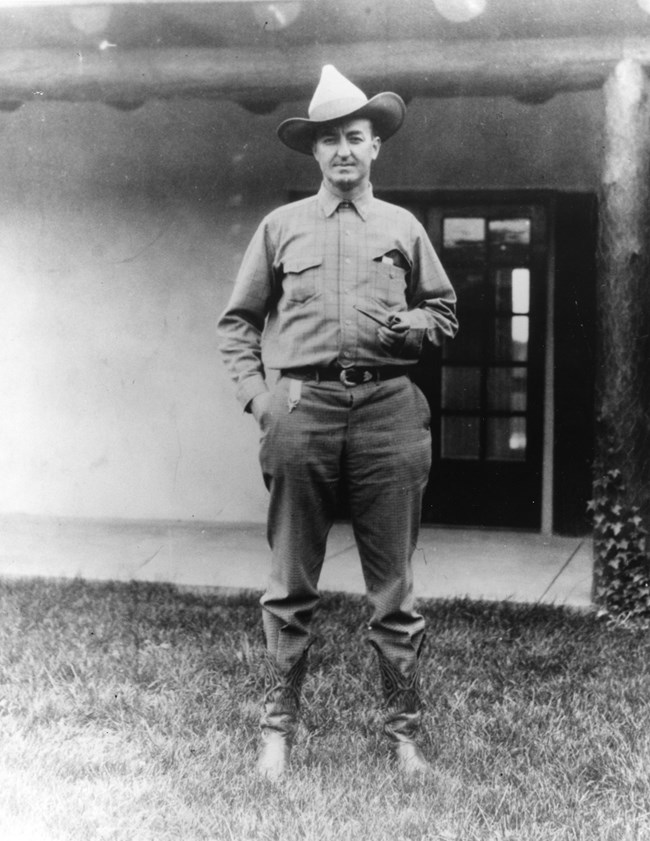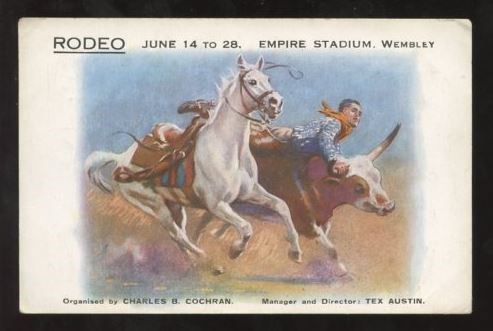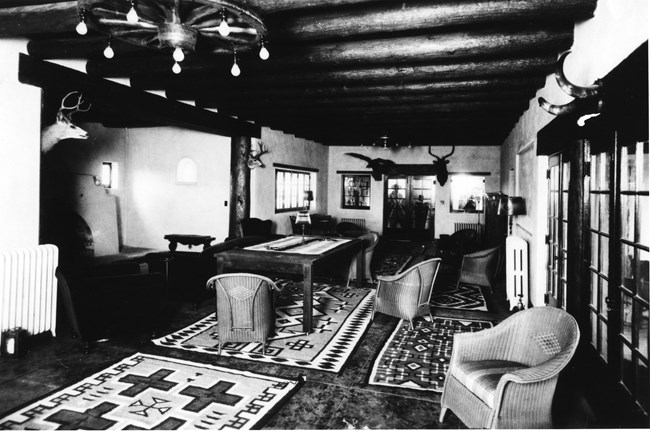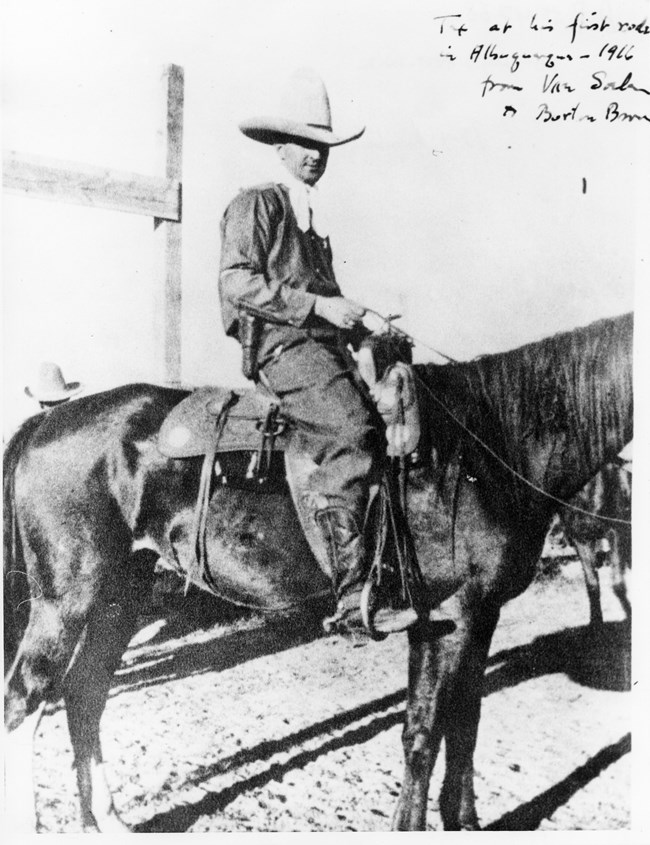
NPS Photo Who Was Tex Austin?
For several years in the 1920s and '30s a colorful but enigmatic character known as Tex Austin owned and operated the Forked Lightning Ranch. Austin's early years are shrouded in mystery. Almost certainly, he was born in Missouri in 1889 as Clarence Van Norstrand. At some point he changed his name to "Tex Austin" and claimed that he was born in Texas and had fought with revolutionaries in the Mexican Revolution. Whatever the uncertainties about his early years, we know that he purchased the 5,500-acre Forked Lightning Ranch along the Pecos River in 1925.
Austin adopted a flashy and distinctive personality for himself. Shortly after he arrived in New Mexico, The Santa Fe New Mexican newspaper described him as "a great big chap - considerably over six feet tall, straight as an arrow, and of striking appearance," wearing a solid gold steer's-head stickpin "the size of a twenty dollar gold piece."

The RodeosBy the time he acquired the Forked Lightning Ranch, Austin was already a well-known promoter of rodeos in the United States and abroad. In 1918 he produced what may have been the first indoor rodeo, in Wichita Kansas, followed by successful rodeos in New York in 1922, London in 1924, and annually in Chicago from 1925 to 1929. At the height of its popularity in 1927, the event attracted 350,000 visitors to Chicago's Soldier Field over a nine-day run. By the end of the 1920s, however, interest in rodeos had declined, and the 1929 event was held at a smaller arena to smaller crowds. By 1934, public reception was cool and Austin's London rodeo that year resulted in a financial loss. Then, as now, rodeos were controversial. In 1924 the Royal Society for Prevention of Cruelty to Animals obtained a court order prohibiting the shows, which was lifted after Austin assured the authorities that calf-roping and other objectionable events would be eliminated. Anti-rodeo activists also protested the 1934 London rodeo, which led to the "Protection of Animals Act of 1934" in England prohibiting some rodeo events. 
NPS Photo Dude RanchingWith the development of the National Park system and the arrival of railroads, the industry of Western tourism flourished during the 1920s and 30s. Businesses like the Fred Harvey Company advertised the attractions of vacations in the Southwest and "dude ranches" provided a way for visitors to experience first-hand the activities of a working ranch. Taking advantage of the interest in Western tourism, Tex Austin opened the Forked Lightning Ranch to visitors. On a bluff overlooking the Pecos River and Glorieta Creek he constructed a ranch house for guests, which he described as "modern in every detail" with a "vista of indescribable beauty." The ranch offered its guests a full range of activities: "Riding parties, picnics, a set of tennis, a round of golf, a game of croquet, horseshoes, or ping pong can be arranged at a moment's notice." Motor trips to nearby attractions were available, "several strings of polo ponies" were in residence, and "each guest is dealt a private horse and that horse is available day or night." Forked Lightning catered to wealthy visitors from the Midwest and East, and its guest list included the social elite and captains of industry of the time. The resort was heavily mortgaged, however, and operated for only seven years before falling victim to the Great Depression. The last visitor left in 1933 and the ranch was placed into court receivership. 
NPS Photo The CrashIn 1935 Forked Lightning was sold and Austin moved to Santa Fe, where he opened "Tex Austin's Los Rancheros Restaurant" near the Plaza. The restaurant offered cowboy fare, dancing, a full bar, and thick steaks - none of those "thin, long steaks with all that musical comedy sauce on it," Austin bragged. For the next few years it was a center for parties, social events, and celebrations. Austin's restaurant effort also proved to be short-lived, however. In October 1938, Austin took his own life, dying by asphyxiation in his car in his garage, leaving memorabilia of his rodeo days and a note asking his wife for "forgiveness." Newspapers reported that at the time of his death he was negotiating to produce another rodeo at the upcoming 1939 New York World's Fair. In 1976, Tex Austin was named to the Rodeo Hall of Fame of the National Cowboy & Western Heritage Museum in Oklahoma City, as one of "rodeo's greatest legends." The LegacySeveral years after the dude ranch closed, Forked Lightning was purchased by Texas oilman E. E. Fogelson and became the part-time residence of Fogelson and his wife, Hollywood star Greer Garson. In 1991 the ranch became part of Pecos National Historical Park. The story of Tex Austin and his version of the Forked Lightning Ranch reflects the America of that era: full of individualism, idealism, and consumerism. The Tex Austin era of Forked Lightning Ranch is now a brief interlude in the long and diverse history of the Pecos Valley and the settlement of the American West. |
Last updated: May 8, 2020
